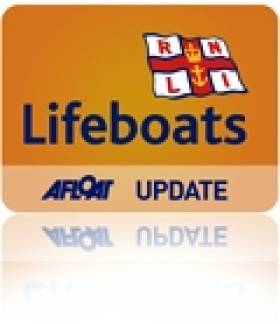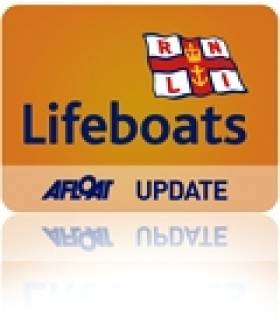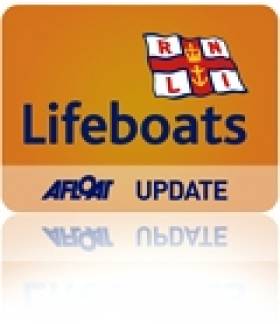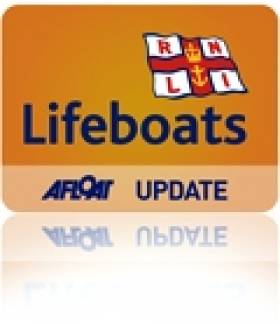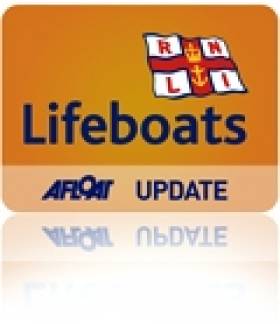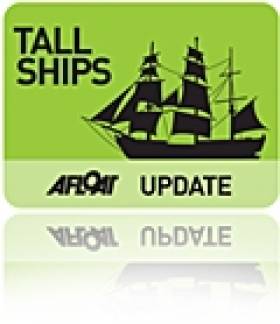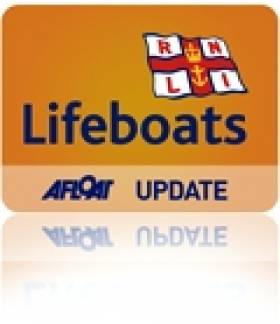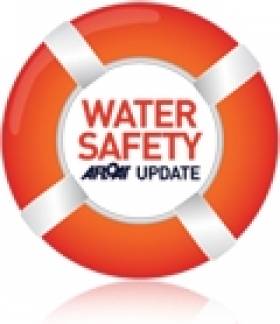Displaying items by tag: Lifeboats
Baltimore RNLI Launches From New Station To Two Flare Sightings
#RNLI - Two red flare sighting in recent days prompted launches by the Baltimore RNLI volunteer lifeboat crew - the first from the new station at Bullpoint.
On Saturday last (27 July) a red flare was reported after 8pm in the area of Inisbeg on the Ilen River, near Skibbereen in West Cork.
Helm Micheal Cottrell and his crew carried out a search as far upriver as the rowing club, making inquiries with vessels on the river. With no trouble found, the search was stood down and the lifeboat returned to the station at 9.10pm.
Then on Tuesday night (30 July) the alarm was raised when a member of the public reported sighting a red flare to the southwest of Tragumna Beach just before 11pm.
The all-weather lifeboat proceeded to Tragumna Bay, where a local fishing boat had already begun a search. Coxswain Kieran Cotter spoke by mobile phone with the observer of the flare, and the lifeboat searched west along the shoreline towards Tragumna Beach in response to the observer's directions.
By midnight nothing had been found, and the search was stood down as all indications were that this was most likely a firework or chinese lantern launched from the headland southwest of Tragumna.
Baltimore RNLI lifeboat operations manager Tom Bushe commented that he was "delighted with how the new carriage launching system worked" and thanked the volunteer crew and shore crew for all their hard work in learning new procedures.
Furthermore he advised that if people are setting off fireworks or releasing chinese lanterns in coastal areas to notify the coastguard of their intent.
Volunteer crew on board the inshore lifeboat were helm Micheal Cottrell, Tadhg Collins and Connor Dempsey, with shore crew comprising Jerry Smith, Rianne Smith and Seamus O'Driscoll. Volunteer RNLI crew on board the all-weather lifeboat were coxswain Kieran Cotter, mechanic Cathal Cottrell, Jerry Smith, Sean McCarthy, Tadhg Collins, Shane McSweeeny and Eoin Ryan.
#RNLI - Enniskillen RNLI will host the revived Castle Island charity swim and family fun morning in Enniskillen, Co Fermanagh on Sunday 11 August.
The swim traditionally took place each year with the support of the Blake family.
And Enniskillen RNLI have hailed as a "great honour" the opportunity for its local volunteer crew to revive the swim in association with sponsors Blakes the Hollow, Western Cars and The Print Factory.
The 750m swim on Lough Erne is open to swimmers of all ages either individually or in small groups such as youth clubs, sports clubs or simply groups of friends.
Enniskillen RNLI says the emphasis for this swim is for everyone to have fun and for that reason, if required, novice swimmers may complete the swim in a well-fitted lifejacket or buoyancy aid but must be confident that they can complete the distance.
Lifeboat crew not swimming themselves will also be present on the day to provide safety cover for the event.
Registration for the swim will take place at 12 noon on the day, followed by a short safety briefing. Sponsorship forms are available by email or can be collected at The Wig & Crown, Blakes the Hollow and Western Cars. For further information contact Adrian at 07974 730456.
In other news, RTÉ Radio 1’s The Business will broadcast live from Bundoran RNLI lifeboat station this Saturday morning 3 August.
The focus of the show will be on the business of Bundoran being a seaside resort - a reputation the Donegal town has enjoyed for more than two centuries.
Speaking ahead of his visit, programme host George Lee said: "I'm really looking forward to broadcasting from Bundoran, particularly on a bank holiday weekend. I'm hoping to experience lots of surfing, slots machines and ice-creams.
"On the show we'll be looking back at the heyday of the dancehalls, we'll be joined by Bundoran regular Ramona Nicholas from Dragon's Den, we'll be speaking to two men making money from oil exploration and lots, lots more."
The Business is broadcast Saturday morning at 10am on RTÉ Radio 1.
Kilmore Quay & Wicklow RNLI In Separate East Coast Assists
#RNLI - Kilmore Quay RNLI has assisted a fisherman after his boat got into difficulty off the Wexford coast, while Wicklow RNLI attended to a fishing boat in trouble south of Wicklow Harbour.
The Kilmore Quay all-weather lifeboat was requested to launch at 9.04am on Monday morning (29 July) to go to the assistance of a local lobster boat with one person on board,
The fishing boat had fouled its propeller while hauling pots a mile to the south-east of the Little Saltee Island.
Weather conditions at the time were blowing a light southerly breeze and there was good visibility.
When the lifeboat arrived on scene, a tow was set up and the vessel was brought safely to the harbour at Kilmore Quay.
Shortly afterwards, Wicklow RNLI launched at 9.30am in response to a call for assistance from a fishing vessel in difficulties six miles south of Wicklow Harbour.
The vessel with three crew was fishing north of Brittas Bay beach when a rope got fouled in the propeller and she lost steering. The skipper contacted the coastguard for assistance.
Wicklow town's lifeboat, under the command of coxswain Nick Keogh, located the vessel drifting close to the Wolf Rock 20 minutes after launching.
A towline was quickly established and the stricken vessel was towed back to Wicklow Harbour, where she was secured safely alongside the East Pier at 10.40am.
The crew on the call out were coxswain Nick Keogh, mechanic Brendan Copeland, Tommy McAulay, Kevin Rahill, Carol Flahive, Paul Sillery and Graham Fitzgerald.
Wicklow RNLI Tows Yacht With Three To Safety
#RNLI - A drifting yacht with three people on board was towed to safety by Wicklow RNLI on Friday morning (26 July). SEE VIDEO BELOW
The volunteer lifeboat crew was alerted by pager shortly before 8am after the Irish Coast Guard received a call for assistance from a yacht in difficulties off Wicklow Head.
The lifeboat, under the command of coxswain Nick Keogh, was alongside the yacht 20 minutes after launching.
Crew member Ciaran Doyle was put on board the boat to assist with establishing a tow line. He remained onboard the yacht as it was towed into Wicklow Harbour.
The boat with the three people was secured safely alongside the east pier at 9.20am.
Weather conditions in the area at the time were described as wind south west force two, and the sea state was calm.
Speaking after the incident, Keogh said: "We located the 14-metre yacht drifting five miles south east of Wicklow Head. The yacht had lost engine power and with the light winds they were unable to make any headway."
The crew on the call out were coxswain Nick Keogh, mechanic Brendan Copeland, Ciaran Doyle, Dave O'Leary, Carol Flahive, Tommy Murphy, Alan Goucher and Peter McCann.
#RNLI - The volunteer lifeboat crew of the Courtown lifeboat launched last Wednesday evening (24 July) to a report of a small fishing boat that was overdue on its time to return to Cahore Pier.
The Courtown RNLI lifeboat, Cahore Inshore Rescue, the Rosslare RNLI lifeboat and the Irish Coast Guard helicopter Rescue 117 were all tasked at 7pm to search the area of Cahore on the north Wexford coast, where the boat was last reported fishing.
After searching for some time, the small fishing boat made contact to say they had beached their boat some eight miles north of Cahore Pier at Kilgorman Beach. Both men were safe and well and all rescue services were stood down.
The Courtown lifeboat has since urged all boat users carry a proper means of communication - ideally a VHF radio - and to keep friends and family up to date on their location, especially if they decide to change their location.
That same evening, Rosslare Harbour RNLI was involved in a search for two fishermen after they reported getting into difficulty off the Wexford coast.
The volunteer crew launched their all-weather lifeboat at 7.30pm to assist in the search following a request from the coastguard to attend a fishing boat that was reported to be taking on water.
Weather conditions at the time were described as good, with a southerly force three wind.
The fishing boat had set out from Cahore Harbour before getting into trouble. The two crew raised the alarm using a mobile telephone.
Rosslare Harbour RNLI and lifeboats from Courtown RNLI and Cahore, along with the Rescue 117 helicopter, joined in the search.
At 7.50pm, Rescue 117 located the two fishermen safe and well and their vessel on the beach at Glasgorman, near Cahore.
Speaking after the call-out, Rosslare Harbour RNLI deputy volunteer lifeboat press officer Jamie Ryan said: "The emergency services responded swiftly and were on scene quickly.
"The two fishermen did the right thing by raising the alarm when they got into difficulty and thankfully they were both found safely ashore."
Four RNLI Lifeboats Rescue Crew From Sunken Tall Ship Astrid
#TallShips - Four RNLI lifeboats were involved in the rescue of 30 crew from the tall ship Astrid, which sank off the Cork coast earlier today (Wednesday 24 July).
The 42m Dutch training vessel reportedly hit rocks inside the Sovereign Islands at Ballymacus Point, near Kinsale.
All on board were brought to safety when the Kinsale lifeboat transferred the casualties from the sinking ship onto the Courtmacsherry RNLI lifeboat and a local vessel. They were then taken to Kinsale.
Both Kinsale and Courtmacsherry RNLI lifeboats were called out at 12 noon today to go to the immediate aid of the sail training vessel that had got into difficulties on the western entrance to Kinsale Harbour in Cork.
Ballycotton and Crosshaven RNLI were also launched, though the Kinsale RNLI lifeboat was first on scene. There was a 2m swell and winds were force five to six.
The training vessel had lost power and was apparently driven on to rocks by a strong southerly wind at the western entrance to Kinsale Harbour. The grounded vessel was taking on water and a crewmember from Kinsale RNLI was put onboard.
Eighteen of the casualties were taken off the Astrid by Kinsale RNLI lifeboat and transferred to Courtmacsherry lifeboa, before being brought to safety. The remaining 12 were put onto a liferaft deployed by the Astrid’s crew, which was towed to safety by the Kinsale lifeboat and picked up by a local vessel.
The people on board the liferaft were then taken to Kinsale harbour and assessed by medical teams.
Irish Coast Guard helicopters from Waterford and Shannon were also on scene along with ambulances and medical crews from Cork.
Speaking about the call-out, Courtmacsherry RNLI coxswain Sean O’Farrell said: “Everyone was very fortunate. I want to praise the quick thinking of the skipper and the crew from the Astrid. They kept calm and did everything we asked them to do. We were able to get them to safety quickly and a major tragedy was averted. To be able to recover 30 people safely was a great day for everyone involved.”
Meanwhile, the Irish Sailing Association has issued the following media statement on behalf of the tall ship Astrid:
Tall Ship Astrid was on a voyage from Southampton to Cherbourg calling in to Kinsale. On board were 23 trainees from France, Ireland, the Netherlands, UK and Spain. The crew were from Belgium and the captain, Pieter de Kam was from the Netherlands.
As the Astrid was leaving Oysterhaven, as part of The Gathering Cruise parade of sail to Kinsale, the vessel experienced engine failure. They notified a nearby RIB which was being helmed by Irish Sailing Association (ISA) CEO Harry Hermon.
The RIB attempted to take a line from Astrid. However, due to the onshore winds and swell this was not possible. Captain de Kam issued a May Day.
The ISA RIB and the yachts in The Gathering Cruise flotilla stood by until the RNLI arrived. There was a safe rescue of all 30 crew who were brought to Kinsale on board the yacht Spirit of Oysterhaven and the lifeboat. All crew were brought to Kinsale Yacht Club where they were provided with showers, food and dry clothing. They were all medically checked and are in good health.
Sail Training Ireland and Kinsale Yacht Club are working together to make arrangements for accommodation and for returning the crew to their homes.
Commenting on the rescue, Captain Pieter de Kam of the Tall Ship Astrid stated: “I would like to thank the lifeboat and the coastguard for the safe rescue of all my crew. We very much appreciate their outstanding work.”
Harry Hermon, CEO of the Irish Sailing Association, commented: “It is thanks to the rescue services that all crew were rescued quickly and safely without injury. I would also like to thank all the sailors from the Gathering Cruise who stood by Astrid providing support to the crew.
"Kinsale Yacht Club has also been fantastic providing food and clothing and helping Sail Training Ireland find accommodation for all the crew”.
#RNLI - The Castletownbere RNLI volunteer lifeboat crew have aided in the recovery of the body of a man from the sea some 2.4km off Travarra on the Beara Peninsula in West Cork.
The lifeboat launched at 1.35pm yesterday afternoon (Monday 22 July) and was joined by Irish Coast Guard helicopter Rescue 115, Derrynane inshore rescue and the Castletownbere coastguard.
A man believed to be in his earl 20s was sighted in the water at Travarra at around 2.30pm and recovered by a local vessel before being transferred onto the RNLI lifeboat and returned to Castletownbere. He was pronounced dead at the scene by a doctor.
Commenting on the call-out, Castletownbere RNLI deputy coxswain Paul Stevens said: “This is a terrible tragedy and we extend our sympathies to the young man’s family and friends.”
Rosslare RNLI Praises Emergency Caller Despite False Alarm
#WaterSafety - Rosslare RNLI has given credit to the quick-thinking member of the public who raised the alarm over what they believed to be a swimmer in difficulty - even though the call-out turned out to be a false alarm.
Lifeboats from Rosslare Harbour and Wexford RNLI were involved in the sea search on Friday evening (19 July) after a swimmer was reported to be in difficulty off Curracloe beach in Co Wexford.
The Irish Coast Guard helicopter Rescue 117 and two local fishing vessels were also involved in the search, which was stood down after an hour and 45 minutes upon coastguard request as no one was reported missing.
Speaking after the call-out, Rosslare RNLI deputy launching authority Dave Maloney said: "The member of the public who raised the alarm this evening deserves credit for doing so."
He added: "We would always encourage the public to alert the emergency services if they see anyone they believe to be in trouble or any signs of danger."
The message is particularly important in a fortnight that has seen a shocking 10 drownings around the island of Ireland - resulting in a big rise in emergency call-outs over the 2012 mid-summer period.
Elsewhere on the same day, the Ballycotton RNLI lifeboat was requested to help search the water off Ballinamona Strand in Ballycotton Bay, Co Cork, for a missing five-year-old girl.
The little girl was playing on the strand when her family lost sight of her. Emergency services were alerted and a search of the area commenced, but thankfully a short while later the little girl was located safe and well.
In other water safety news, the Irish Coast Guard has issued a public appeal for help locating a training mannequin that was lost in Galway Bay during an exercise off Blackhead in North Clare last week.
The Connacht Tribune reports that five coastguard mannequins were placed in the water to acts as people who jumped overboard from a ship fire - but only four were recovered afterwards.
Open Day Success at Wicklow Lifeboat Station
#RNLI - A steady stream of people were welcomed by Wicklow RNLI at the lifeboat station's annual open day on Sunday 14 July.
Doors opened at 11am and the volunteer lifeboat crew was on hand to give tours of the station and its two lifeboats.
Activities included face painting and a joint display by Wicklow Fire and Ambulance Services. Garda, Customs and Civil Defence also put on displays throughout the afternoon, while the Irish Coast Guard helicopter flew over with the winch crew waving to the crowd below.
The final display was a simulated call-out of the inshore lifeboat. The three crew members onboard demonstrated how fast they could get into their lifeboat gear and launch.
The planned exercise involved a rescue to an injured sailor from a boat which was located in front of the crowd. The crew handed him over to a waiting ambulance.
Folk group Sheringham Shantymen travelled from Norfolk for the open day to see the station's inshore boat, which the group funded and which was named in their honour at a ceremony in 2007.
The Shantymen entertained the crowd with music and concluded the open day with a rendition of the lifeboat anthem, Home From The Sea.
Speaking after the event, Wicklow RNLI volunteer lifeboat press officer Tommy Dover said: "We have had a fantastic weekend with the Sheringham Shantymen. One of the highlights was the concert on Saturday night where the crew was invited to join the group on stage to sing Home From the Sea.
"The crew has a long association with the Shantymen and the lifeboat they funded has rescued 32 people to date at Wicklow."
Meanwhile, a successful sea safety roadshow was held at Sligo Bay RNLI during the weekend's Sea Shanty Festival.
Numerous lifejackets were checked with many having various faults such as corded cylinder, loose cylinder or out of date firing heads. Many people also sought advice about flares, anchors and VHF radios.
RNLI Sea Safety Roadshow adviser Joe Morr said: "It was a very successful weekend in Rosses Point and I hope to bring the roadshow back again next year."
Achill Island Lifeboat Assists Four In Two Sunday Launches
#RNLI - Achill Island RNLI responded to two separate incidents off the Mayo coast last Sunday 14 July.
The volunteer lifeboat crew was first requested to launch in the early hours of Sunday morning and again in the evening of the same day.
The crew on board the station’s all-weather lifeboat responded to a call-out a few minutes into Sunday morning when a red flare was reported to Malin Head Coast Guard Radio Station.
The flare was believed to have been seen on the Westport side of Clew Bay. The lifeboat searched the area but nothing was found and the crew returned to station at 3am.
The second incident happened at around 7.30pm when a cruiser with four people on board reported to Malin Head Coast Guard that it had engine problems and was disabled.
This was in the vicinity of Old Head on the south side of Clew Bay, and the Achill lifeboat was requested to assist the vessel.
af The casualty vessel was towed to Old Head Pier by another boat that was close by, and the lifeboat ensured that all were safe before returning to station.


























